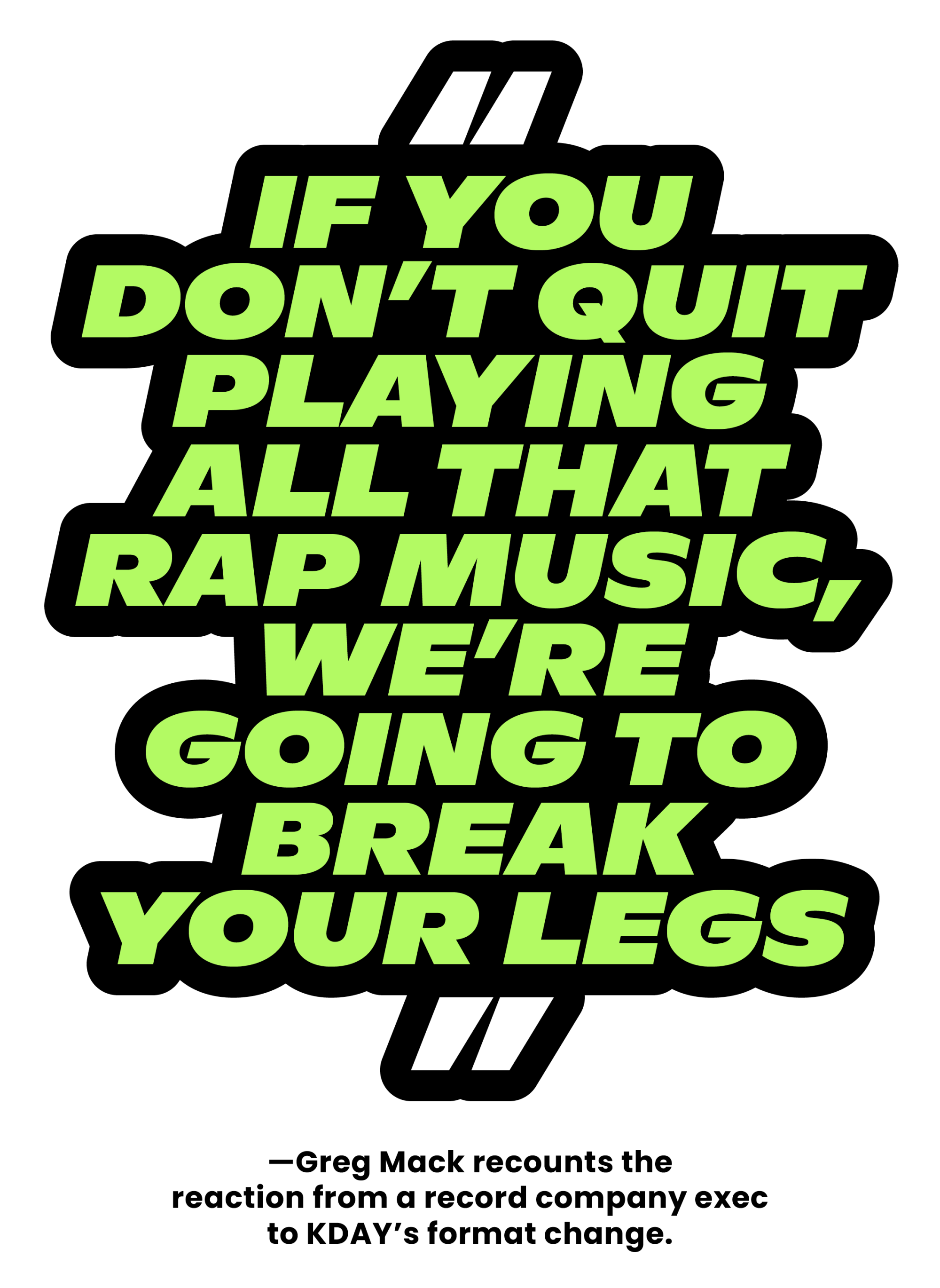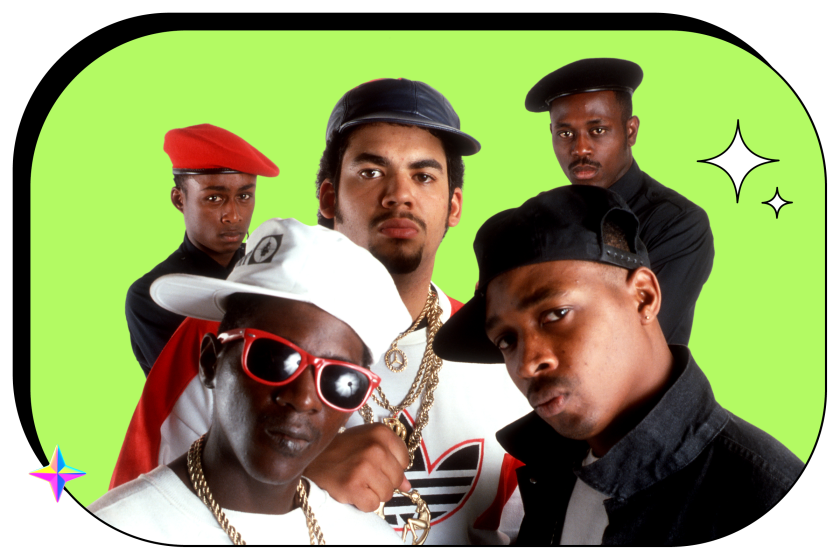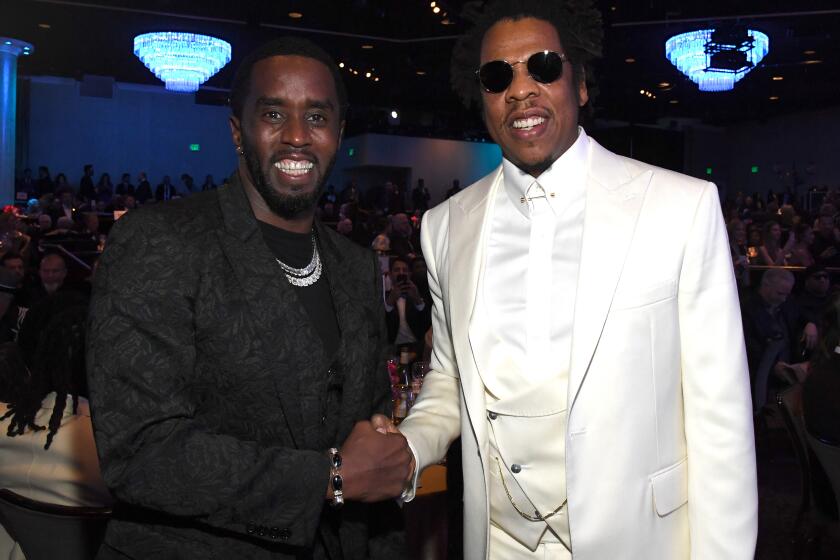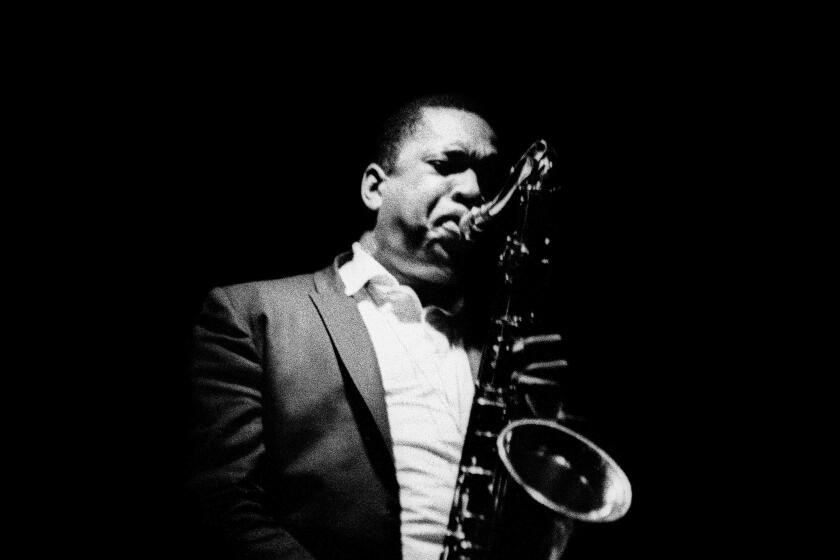
- Share via
A week after moving to Los Angeles from Houston in 1983, Greg Mack wandered into Ameraycan Recording Studios in North Hollywood, ready to shake some hands at an industry party. Recently hired as the music director for KDAY-AM (1580), Mack, 23, was there on a direct invitation from singer Ray Parker Jr., who owned the studio, and found himself talking with Parker and famed soulman Barry White soon after he walked in.
“I still had that Texas twang, and as I was talking, Barry just started laughing,” Mack said. “I was like ‘What?’ and he said, ‘Man, I’m not laughing at you, I’m just feeling you. You’re like a breath of fresh air.’
“‘You’re gonna do just fine,’” Mack recalled White telling him. “‘Control this city, don’t let this city control you.’”
White’s words were a striking premonition. When Mack came aboard as music director, KDAY, which first signed on the air in 1948, ranked fifth out of five urban-format radio stations in Los Angeles.
“They had a younger demographic,” said Lonzo Williams, promoter of the L.A. electro group World Class Wrecking Cru and owner of the Eve After Dark nightclub in Compton. “They played R&B and funk... artists like Tom Browne, Cameo, Frankie Smith’s ‘Double Dutch Bus.’”
Within 90 days of Mack’s hiring, however, KDAY leapfrogged all the way to No. 2, outranked only by the sole urban-format FM station in the city, KACE (103.9).

Mack’s secret? The music director rolled down his window on a drive through South-Central and heard rap music: Run-D.M.C., Kurtis Blow and the Sugarhill Gang, to be specific.
When he first took the burgeoning genre to the station’s brass, however, they were skeptical; radio execs viewed hip-hop as a novelty, if that. But later that day, Mack found a KDAY boss willing to give it a shot.
“Everybody knew that if you asked [general manager Eddie Kirby] for anything after lunch, he’d agree to it, because he’d just went out and had three drinks,” Mack laughed. “So we met again that afternoon, and this time he says, ‘We’ll give it a try.’ And that thing exploded.”
KDAY became the country’s first radio station to play hip-hop on a full-time basis. In addition to programming the more established East Coast acts, Mack would bring on neighborhood artists to promote themselves live on air, and, in the process, spread the word about KDAY to friends and family. It was the old-school version of influencer culture.
“One of the first shows World Class Wrecking Cru did was at Fremont High School, opening for New Edition,” Williams remembered. “KDAY had a contest, and whatever school won got a free concert with New Edition. I got World Class Wrecking Cru to be the opening act, and then we brought everyone to Eve After Dark that night.”

When Mack agreed to join KDAY in 1983, he knew the struggling station was up for sale; as ratings spiked, the station was quickly taken off the market. But he still weathered criticism from less-than-enthused parents and politicians, and more than a few threats from record executives, angry that their often payola-backed tracks were suddenly getting less and less airplay.
“If you don’t quit playing all that rap music, we’re going to break your legs,” he recalled hearing from a record company exec at the time.
But with waves of new listeners tuning their dials to KDAY, the successes drowned out the detractors. After playing records from hip-hop stars across the country, Mack brought many of them to the city to perform as part of the station’s “Friday Night Lives” series, from LL Cool J to UTFO to Queen Latifah to KRS-One. Outside of hip-hop, Mack worked to increase Latino listenership by programming freestyle music, a subset of dance music that rose to popularity in the mid- to late 1980s.
But his most essential creation was a group of DJs called the Mixmasters, who brought intricately woven mixes to the airwaves beginning in 1984. Soon after arriving in Los Angeles, Mack’s sister took him to a packed L.A. Sports Arena to see Uncle Jamm’s Army, a DJ crew that boomed bass-heavy cuts.
Mack wanted to bring the crew onto the airwaves to liven up his broadcasts, but founder Rodger Clayton was less than impressed with KDAY’s reach once Mack tracked him down, motioning instead to the thousands of kids dancing in the crowd.
“‘Does it look like I need m—f— radio?’” Clayton asked Mack.
Undaunted, Mack resolved to create his own team of DJs and mentioned the idea to Williams. There were several notable DJs on the Wreckin’ Cru roster, and Williams offered to bring around two in particular to spin for Mack: DJ Yella and Dr. Dre.
“I had never in my life heard anything like that,” Mack said. “It wasn’t your ordinary mix, it was more of a production. Dre would take a beat and make it about 30 minutes long. And then he’d take another beat and drop it over. He would go about eight channels deep... he probably would have gone even deeper, but he only had an eight-channel board.”
Dre and Yella brought the station a new mix every day, while Mack gave on-the-air shoutouts to Williams’ new club, Dooto’s, and teamed up with the promoter for joint events. When Dre and Yella opted to devote more time to N.W.A, Mack went elsewhere to solidify his rotation, bringing on DJs Tony G, Ralph M, Aladdin and Battlecat, among others.
Over the next few years, Mack and his Mixmasters ruled the airwaves. One of Mack’s biggest regrets is not trademarking the “traffic jam” catchphrase, which blared up and down L.A. freeways during rush hour and remains a radio staple. Meanwhile, the Dr. Dre connection paid off again, when the fast-rising producer swooped into a club one night where Mack was DJ’ing.
Dre wanted to introduce him to the latest artist he was producing, and he took Mack outside to meet Eazy-E and play him what they’d been working on.
“We go outside to sit in my car, since it had a cassette player, and they put on ‘Boyz-n-the-Hood,’” Mack said. “I said we’d play it, but we needed a clean version, since it had all kinds of cussing in it.
“The very next day, Dre came back with a clean version, and it exploded,” Mack said. “It was our most requested song within 48 hours. I’d never seen anything like it.”
In 1988, Black rage — over social conditions, over police violence, over the scourge of crack — fueled coast-to-coast landmarks from Pubic Enemy, N.W.A and Ice-T.
Eazy-E and N.W.A’s rise came as gang culture had taken a stranglehold on Los Angeles. Motivated to act after 40 people were injured in Long Beach at a scheduled Run-D.M.C. concert in August 1986, KDAY organized a “Day of Peace” on Oct. 9, 1986.
Run-D.M.C., White and other notable figures took over the airwaves to call for an end to the violence, while Angelenos across the city phoned in to express how gang culture had affected them and their loved ones. Less than a month later, members of the Bloods and the Crips signed a peace treaty.
“Back then, gangs didn’t just shoot to be shooting; if they were shooting, you really did something,” Mack said.
Later that decade, though, KDAY’s dominance began to wane. Audiences endured the subpar AM audio quality while there wasn’t a better option, but once Power 106, KPWR, brought rap to the FM airwaves, the migration was on.
In 1990, KDAY was sold to real estate investor Fred Sands, who would switch the station to a business format with the letters KBLA, marking the official end of a storied run. Still, KDAY’s success sparked a number of hip-hop-focused stations across the country, helping push the genre to greater heights in the decades to come. (A rebranded KDAY launched at 93.5 FM in 2004, where it remains today, playing classic hip-hop.)
Forty years after making hip-hop history, Mack lives in Bakersfield, hosts the syndicated “Greg Mack Show” (which broadcasts on 30 stations) and recently purchased his own radio station, where he’s programming a format he calls “the new generation of old school.”
He didn’t picture hip-hop growing into what it’s become; he jokingly added that he probably would have taken it more seriously.
“I had no fear,” he said. “This country boy, growing out of poverty, coming to Los Angeles to change the world. Because we did change the world.”
More to Read
The biggest entertainment stories
Get our big stories about Hollywood, film, television, music, arts, culture and more right in your inbox as soon as they publish.
You may occasionally receive promotional content from the Los Angeles Times.













